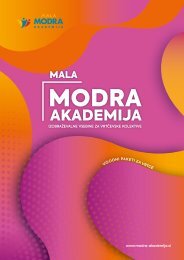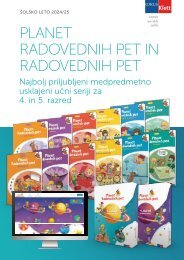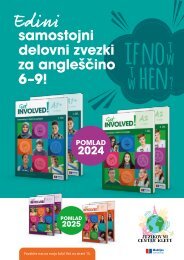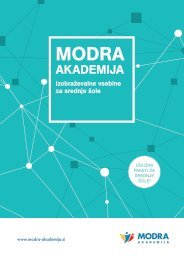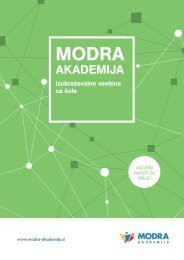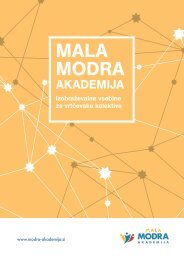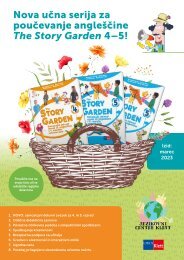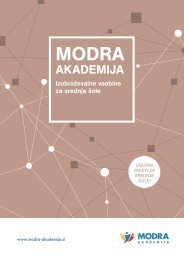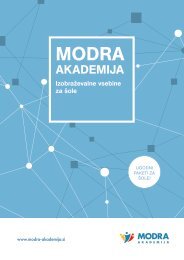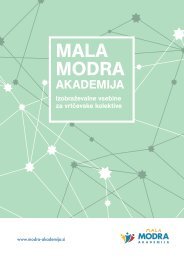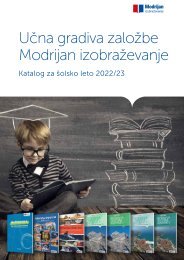You also want an ePaper? Increase the reach of your titles
YUMPU automatically turns print PDFs into web optimized ePapers that Google loves.
Activity 10<br />
Activity 1<br />
(below).<br />
Activity 12<br />
Activity 13<br />
Good-Bye<br />
Activity 14<br />
Activity 3<br />
Activity 1<br />
Activity 2<br />
Activity 5<br />
Activity 4<br />
Zasnova učne<br />
ure angleščine<br />
z Lili in Binetom<br />
Slikovna časovnica omogoča učencem stalno<br />
seznanjenost s potekom učne ure. Zaradi uveljavljenih<br />
rutin se bodo počutili varne, zato bo pouk učinkovitejši.<br />
Uvod in ogrevanje<br />
Uro pričnemo s pozdravno pesmijo ali recitacijo,<br />
ki učence ogreje za pouk angleščine.<br />
tter<br />
m<br />
nd<br />
ne<br />
Medpredmetni delovni zvezek<br />
Lili in Bine 2<br />
je izhodišče za dejavnosti pri pouku angleščine. Gradivo<br />
za angleščino sledi strukturi desetih tematskih sklopov v<br />
delovnem zvezku, na katere se vsebinsko smiselno naveže.<br />
Tako se vključi tudi v obstoječe tedensko načrtovanje<br />
medpredmetno povezanega pouka za vse predmete.<br />
Dejavnosti so kratke, zabavne in se ponavljajo.<br />
Program predvideva pogosto uporabo glasbe,<br />
petja in gibanja, saj je s tem zagotovljeno boljše<br />
pomnjenje. Če je učitelj do petja zadržan,<br />
lahko pesmi recitira.<br />
Faza A<br />
Faza A se posveča besedišču posameznega<br />
tematskega sklopa, ki ga gradimo skozi pesmi, recitacije<br />
ali dialoge in spiralno nadgrajujemo. Vsak teden znotraj<br />
sklopa prinese novo nadgradnjo, isti vsebinski sklop<br />
pa se leto kasneje naveže na svojega predhodnika.<br />
Besedišče ponazarjajo slikovne kartice na<br />
geometrijskih likih (slikovni prikaz izgovorjene besede<br />
ali preproste povedi). Te na nezavedni ravni omogočajo<br />
prepoznavanje besednih vrst in vzorcev besednega<br />
reda ter gradijo temelj za kasnejše preprostejše učenje<br />
branja in slovničnih struktur.<br />
Primer vizualno podprte povedi:<br />
NOVO<br />
TOPIC 1 TOPIC 1<br />
School School<br />
Have the children get their flash cards and bring them to the floor. Si ting on the floor, review<br />
Time permi ting, play a quick visual game. Show a pair of like cards and ask, “Are they the<br />
the flashcards taught it PART A. Have the children review the expre sion “This is a …” by<br />
same?” If the cards are different (e.g. show the new school & the old school), the students must<br />
asking them, “What is this?” As the children say, “This is a …” they pick up their flash card, while<br />
stand, jump and say, “They are different.” If the cards are the same (e.g. show the new school<br />
you stick their picture on the board. Have children take turns asking, “What is this?” to the<br />
& the new school), the students remain seated, turn around in their place and say, “They are<br />
cla s. Individual students can answer. Remember to expect answers in Slovene, but repeat<br />
the same.” This activity is about developing sp ed recognition based on visual stimuli. The<br />
them in English so tha the students are exposed to the vocabulary as much as possible.<br />
students must respond quickly to the picture.<br />
Reinforce the expression with the visual grammar cues (below).<br />
Visual Grammar example<br />
REFLECT & CONNECT<br />
Show the students on the visual timetable that it is now time where you wi l speak Slovene.<br />
Have the students return to their desks and ask them in Slovene whether or no they think<br />
they understood what was being taught/learned so far (including the weather song, seasonal<br />
This is a teacher.<br />
song/poem/verse/recitation). Some example questions and statements could be:<br />
Te l me what you liked abou this activity.<br />
What did you find cha lenging abou this activity?<br />
Was learning today easier or more di ficul than you thought? Te l me why you thought so.<br />
Take 2 identical pictures (e.g. new school & new school) from the teacher flashcard set and<br />
• 2 thumbs up if you can remember 2 or 3 words.<br />
hold them nex to one another. Ask the students, “Are the teachers the same?” Elicit a response<br />
of “yes,” by nodding your head, or “no,” by shaking your head. You may even balance the<br />
pictures to show they are equal. Elici the students to say, “yes.” and say, “They are the same.”<br />
CONCLUSION<br />
Repeat this with the other pictures that are the same. Reinforce the expre sion with the visual<br />
grammar cues (below).<br />
Take 2 different pictures (e.g. old school & new school) from the teacher flashcard set and<br />
Te l (gesture) students to stand to sing the good-bye song in rote fashion until the students<br />
hold them nex to one another. Ask the students, “Are the teachers the same?” Elicit a response<br />
know the song.<br />
of “yes,” by nodding your head, or “no,” by shaking your head. You may even unbalance the<br />
pictures to show they are different. Elici the students to say, “yes.” and say, “They are different.”<br />
Repeat this with the remaining cards. Reinforce the expre sion with the visual grammar cues<br />
Good-bye song<br />
Visual Grammar example<br />
Good-bye to you, good-bye to you.<br />
Let us a l say, good-bye to you.<br />
Go to www.lilibi.si to listen to the song.<br />
They are the same. They are different.<br />
18 19<br />
School School<br />
Explain to students in Slovene how the le son wi l go by displaying the visual timetable (see<br />
Fo low the gr eting song with some short and quick song, poem, tongue-twister, recitation<br />
example above). Place the visual timetable on the board or have a ready-made frame for it<br />
and/or verse. This wi l help the children to ge their tongues and mouths warmed up for English,<br />
hung on the wa l and stick pictures to it.<br />
and add a bit of laughter and expre sion each time. Try to add a few gestures and actions if<br />
po sible.<br />
Seasonal song/poem/recitation/verse/tongue-twister (examples)<br />
Inform the children when you wi l be speaking Slovene (a the beginning – intro – and during<br />
the Reflect & Connect sections), otherwise you wi l be speaking to the students only in English.<br />
1. Poin to the window, poin to the door, jump to the ceiling, stomp on the floor.<br />
You can put a picture of yourself on the visual timetable to indicate the times you wi l be<br />
2. Ten super sausages, si zling in a pan. One goes (snap), another goes (clap).<br />
speaking to them in Slovene. You may even wish to ask a studen to pu the pictures up as you<br />
Nine super sausages, si zling in a pan. One goes (snap), another goes (clap).<br />
explain the timetable. You can explain the timetable by saying:<br />
etc.<br />
For example (in Slovene): “Today we wi l begin with our gr eting/he lo song fo lowed by<br />
Go to www.lilibi.si to listen to ideas for this section.<br />
our pointing poem, tongue-twister on sausages, and our weather song. Then we wi l<br />
sing a song/recite a poem about school ca led “Let’s Go To School.” Then you wi l come to<br />
the floor and we wi learn some new words about our cla sroom. When you see my picture,<br />
we wi l talk in Slovene and you can te l me what you think and how you feel about what we<br />
have learned today so far. I wi l ask a few different students each time. Then we wi l continue<br />
with math. We wi l start by counting using our bodies and learn about (s e PART B). After the<br />
Conclude with the weather song. Make certain you place the weather picture on the visual<br />
math section, you can te l me in Slovene about what you know and understood. We wi l<br />
timetable a cording to the weather the day you wi l be singing.<br />
finish our le son with our good-bye song/poem.”<br />
Weather song<br />
Your students wi l appreciate knowing exactly what they are doing at every stage of<br />
the le son. Students of a learning abilities and disabilities wi l be able to follow the<br />
How’s the Weather?<br />
structure and rhythm of the le son. It should also help with minimizing any student<br />
How’s the Weather? It’s SUNNY (depending on the weather that day).<br />
disturbances.<br />
How’s the Weather? It’s SUNNY.<br />
How’s the Weather? It’s SUNNY.<br />
It’s SUNNY today.<br />
Start your lesson with the gr eting song o recitation. Add actions to the song when you can<br />
Go to www.lilibi.si to listen to the song.<br />
(e.g. shake hands when you say “welcome,” swing your arm for “come on in,” and jump and<br />
throw your hands in the air when you say “fun,” etc.).<br />
PART A<br />
Greeting song/recitation<br />
4 Weeks – 8 Le sons<br />
Welcome, Welcome<br />
Welcome, welcome to our class. We’re so glad you’re here.<br />
Lesson objectives<br />
Welcome, welcome to our cla s. We’re so glad you’re here.<br />
PART A: Recognizing cla s items, learning to read sentences represented by<br />
Come on in and join the fun. School is fun for everyone.<br />
shapes.<br />
Welcome, welcome to our class. We’re so glad you’re here.<br />
PART B: Counting, making a ta ly chart, reading a ta ly chart, learning to read sentences<br />
represented by shapes.<br />
This song is sung to the tune of Old MacDonald. Go to www.lilibi.si to listen to the song.<br />
TOPIC 1 TOPIC 1<br />
7+6<br />
8 9<br />
10+3<br />
Priročnik za učitelja English with<br />
Lili and Bine in dnevne priprave<br />
Priročnik za učitelja predstavi zasnovo gradiva in ozadje<br />
pristopov, na katerih temelji, pa tudi strukturo učne ure<br />
in posamezne elemente, ki sestavljajo komplet. Za<br />
lažjo uporabo je razdeljen na posamezne tematske<br />
sklope, podobno kot medpredmetni delovni zvezek,<br />
zajema pa vse pripadajoče materiale za preprosto<br />
načrtovanje in učinkovit pouk. Priročnik in učne<br />
priprave bodo kmalu brezplačno dostopni na<br />
prenovljenem izobraževalnem portalu Lilibi.si.<br />
I am a teacher.<br />
5 minut za refleksijo<br />
Vmesna faza ponuja premor in možnost ocene<br />
naučenega, izmenjave mnenj in za učitelja dragocenih<br />
povratnih informacij.<br />
Faza B<br />
V fazi B naučeno besedišče uporabimo v povezavi z<br />
vsebinami drugih predmetnih področij. Dejavnosti<br />
so vezane na učno uro in vsebino drugega predmeta,<br />
obravnavano v istem tednu. Fleksibilnost programa<br />
pa se kaže v učiteljevi možnosti izbire med dvema ali<br />
tremi predmeti.<br />
Zaključek<br />
Stalnica, s katero strnemo učno uro angleščine<br />
in napovemo nadaljevanje pouka v slovenščini,<br />
je poslovilna rutina.<br />
15






